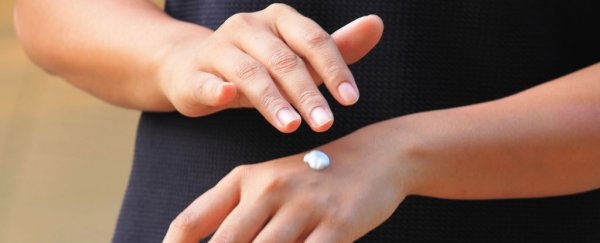Cultivating 'friendly' bacteria from people's skin makes it possible to develop personalised lotions to treat skin conditions like eczema, a new study shows.
It's the latest evidence that beneficial bacteria in our microbiome can be used to treat infections spurred by harmful microbes, and could provide a new direction in antibiotics research: something we desperately need, in light of rising antimicrobial resistance.
While everybody's skin is populated with a mixture of healthy and harmful bacteria, the ratio of good to bad isn't always the same. This imbalance could help to explain why some people have conditions like atopic dermatitis (AD) – the most common form of eczema, which produces inflamed and irritated skin, and affects almost 18 million Americans.
"People with this type of eczema, for some reason that's not quite known yet, have a lot of bacteria on the skin, but it's the wrong type of bacteria," dermatologist Richard Gallo from UC San Diego told the Associated Press.
"They're not producing the antimicrobials they need."
To find out about the makeup of these bacteria populations, Gallo and his team examined skin culture swabs taken from 30 healthy people and 49 subjects with AD.
After screening thousands of colonies of bacteria, they found that the skin of healthy people is rich in two bacterial species – Staphylococcus hominis and Staphylococcus epidermis. Both of these are known to defend against a harmful kind of bacterium called Staphylococcus aureus – aka Golden Staph, the precursor to the deadly superbug MRSA.
Dermatologists don't know if Staph actually causes AD, but it's been shown that the bacteria can help promote AD symptoms – with studies going back as far as the 1990s demonstrating that the density of S. aureus colonies corrolates with the inflammation and severity of eczema.
In Gallo's research, the team found that people with AD don't exhibit large populations of S. hominis and S. epidermis, while S. aureus was found to abundant.
To see if it would be possible to give people with low levels of these beneficial bacteria a boost, the researchers ran another experiment, isolating S. hominis and S. epidermis cultures from five participants with AD.
After isolating strains that counter S. aureus thanks to the production of proteins called antimicrobial peptides (AMPs), the team grew more of these bacteria in the lab.
Once they'd boosted the population counts of these healthy bacteria, the researchers mixed them into a moisturiser, giving each participant a personalised skin lotion sourced from their own microbiome.
Applying the lotion to participants' arms to give them about the same amount of beneficial bacteria as the healthy participants – about 100,000 colony-forming units per square centimetre of skin – saw S. aureus disappear completely in two patients within just 24 hours, while dropping significantly in the three others.
The researchers haven't announced if the physical symptoms of AD eased up in addition to the S. aureus count being reduced, but they are confident that they've found the basis of a working treatment here.
"We now have a rational therapeutic approach for atopic dermatitis by using bacterial transplant technology," Gallo said in a press release.
"It appears that people with this disorder will need to have it reapplied because their body does not naturally promote the growth of these organisms. The good thing is this is easy to do because it's just a cream."
Better still, compared with broad-spectrum antibiotics that kill a wide range of bacteria – both good and bad – the researchers' technique enables them to cultivate strains that only target harmful bugs.
"[Antibiotics] not only target S. aureus, but also kill beneficial bacteria," Gallo told Ed Yong at The Atlantic. "Our approach identified antimicrobials that have evolved to kill S. aureus while leaving the good bacteria alone."
We should keep in mind that this is a very small study so far, with the lotion just having been tested on five participants for a short period of time – the participants only applied the cream once, with the results being checked 24 hours later.
But there are reasons to be optimistic, with the team now conducting a much larger clinical study, involving 60 patients using personalised lotions for longer periods – up to weeks and months in duration – to see how treatments pan out in the long term.
Until we hear those findings, we shouldn't get too carried away about the results of this study, but hopefully there's more good news to report on this in the future.
"It's a big step towards using microbial therapies to treat skin disease," immunologist Shruti Naik from Rockerfeller University, who wasn't involved with the study, told The Atlantic.
"It will be interesting to take it a step further, and test if the beneficial microbes can dampen or cure eczema."
The findings are reported in Science Translational Medicine.
